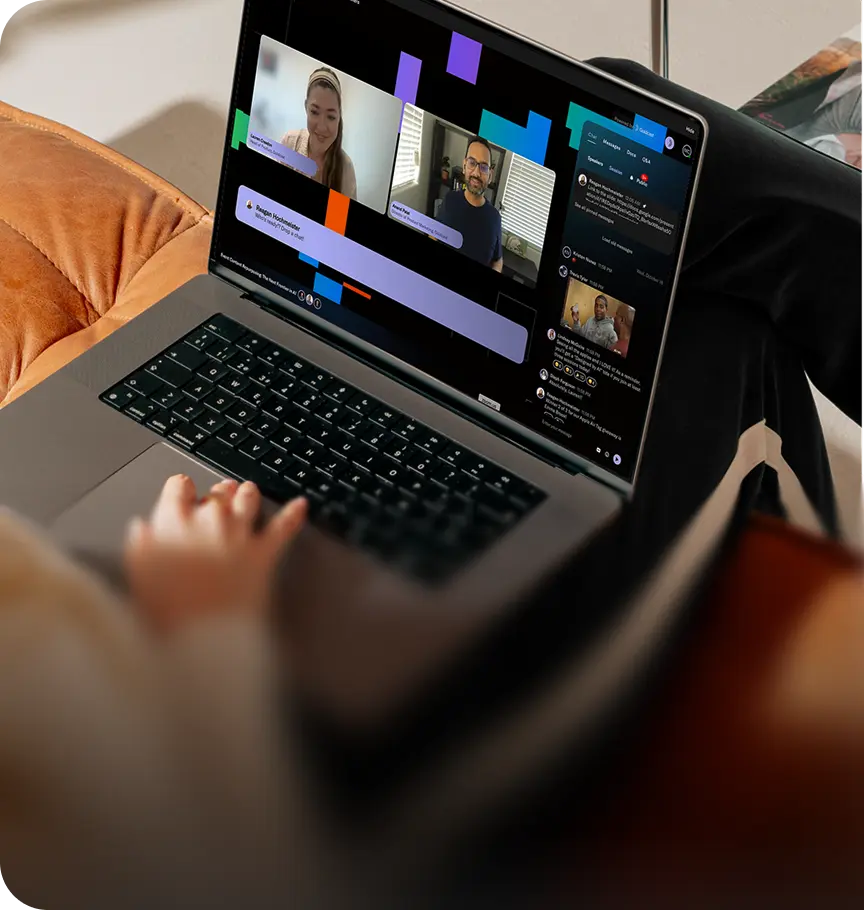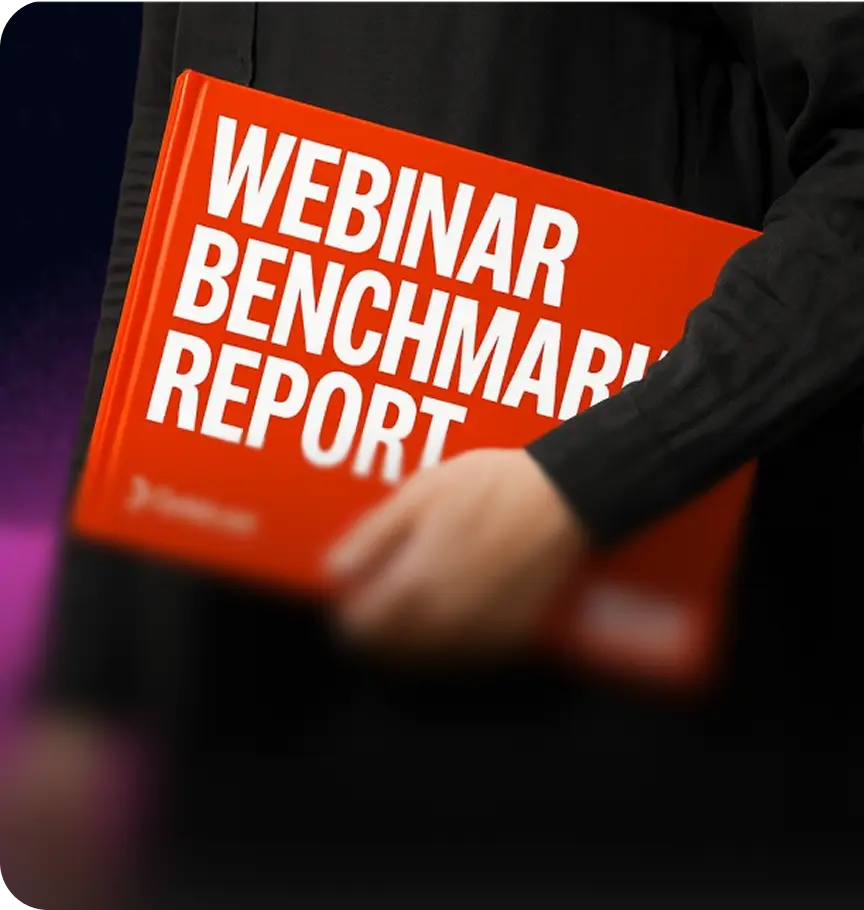Guide to Writing Podcast Scripts (With Template & Examples)

Table of Contents
Maximize Your Marketing ROI
Join 10,000 other marketers already getting the best tips on running engaging events that boost pipeline and create raving fans.
Guide to Writing Podcast Scripts (With Template & Examples)
Podcasting has evolved from a niche passion project into a cornerstone of modern B2B marketing, with brands using podcasts to capture attention, build trust at scale, and stay top-of-mind with decisionmakers.
And the secret to a killer podcast episode? You might be surprised to learn it's not the fancy microphone or professional editing software. While quality does matter, there's something else that affects your own podcast much more: the script.
A strategic, well-crafted script is the backbone of your podcast. Your script keeps you consistent, gives you direction, and ensures that your podcast efforts align with your greater business goals. Take the time to create an intentional script before your episode, and you'll save so much time on the backend when it comes to editing.
Plus, you can "plant" moments for later repurposing when you use a script, turning your recordings into many different types of valuable content and building Mindshare. When you include intentional hooks, on-brand moments, and quotable takeaways into your podcast script, you're creating content that will drive engagement well into the future.
Let's get into:
- Why podcast scripts are so valuable
- Podcast script templates you can start with
- Delivery tips to try in your next podcast episode
Why a podcast script is the most valuable tool in your workflow
Most podcasters see scripts as a way beginners can reduce rambling. There's sometimes this idea of, "Well, if you're a truly great podcaster, you shouldn't need a script."
That couldn't be farther from the truth! In reality, scripts are blueprints for quality and consistency. Seen through that lens, it makes sense why everyone needs a script — you wouldn't ask an architect to start executing on his vision for your home without approving a blueprint, right?
When done well, scripts ensure that your brand voice is consistent and your key messages are being reinforced. After episodes are over, scripts then become part of a living archive that people on your team can reference to see how something was discussed.
The goal is always to build a repeatable, scalable content workflow to drive Mindshare and revenue. So, your podcast is never just one recording — it's a building block in the content workflow. It's one piece of valuable content that you will later repurpose into other pieces of valuable content.
And it will require a script to pull all of that off, every time.
We keep bringing up Mindshare because you must keep it on your radar as you write scripts. You want to be on people's minds when they're ready to buy, and the way to do that is by creating valuable, engaging content they're interested in.
What that means for your scripts, specifically, is that you'll be thinking of attention-grabbing hooks, moments to show your brand personality, ways you'll provide value to listeners, and times you can spark debate or conversation.
Scripts also enable data-driven optimization. Because you'll have the archive of your scripts, complete with the CTAs/intros/transitions/etc that you used for each episode, you can look for patterns among episodes with high engagement or listeners. You can also see if you did anything differently if there's an episode where people drop off. This allows you to iterate on your script for the next time, improving each episode as you go.
Turn Your Podcast Into A Content Engine
Record professional-quality episodes and automatically generate multiple content assets with Goldcast's AI-powered platform.
How to write a script (+ podcast script example)
You don't have to reinvent the wheel every time you record. Your podcast script is a repeatable structure that makes episodes feel professional, engaging, and familiar to listeners — no matter what topic you're covering. Each section of the script has a pivotal role to play in keeping listeners hooked, while delivering value.
We'll walk through the different parts of the script in this step-by-step guide and share a sample script you can build from:
The opening sequence (first 0-90 seconds)
The first few moments of your episode set the tone and determine whether listeners stay or leave. In fact, NPR research found that a typical episode loses up to 35% of its audience within the first five minutes.
Grab attention immediately during your podcast intro with a compelling question, surprising stat (like the NPR one we just shared), or a bold statement. Give people a reason to stay. Work in your intro music or taglines to build consistency, and share the roadmap with folks. Where are you going in this episode? What will they gain from listening?
Mark your "hook moments" explicitly in the script so you give them the proper focus as you record; afterward, they can also be easily clipped and amplified across channels to build interest with other potential listeners. (Psst: If you use Goldcast Recording Studio to record, your recording will be available in Content Lab to quickly repurpose into blogs, social media clips, and other assets.)
How to script guest introductions
Go beyond the basics of name, title, and company. Highlight why you've selected this guest, at this time, to be on your podcast. What expertise and unique experiences do they bring? Why should this matter to your audience?
Guest intros keep you consistent with each episode (yes, we know we are consistently talking about being consistent, but it's so important!), and they further hook your audience. Now that they understand all they stand to gain from listening in on the convo, they don't want to leave.
Structured content blocks and segments
Now, break your episode into 2-4 more in-depth podcast segments, each with its own talking points, supporting data, and "free time" for anecdotes or rabbit holes (the good kind, that is). This will help you stay on track and maintain a conversational flow, while ensuring you hit all of your key points.
How to script smooth podcast transitions
Plan ahead how you'll segue between podcast topics to keep momentum going. Use phrases, cues, or even light sound effects to signal to listeners that you're changing gears.
Some transitions we like:
- Speaking of XYZ, let's chat now about…
- That brings me right to our next point…
- Next up…
- Finally….
Scripting outros and CTAs that drive action
It's time for closing remarks. Reinforce the main points you want people to remember, and provide clear next steps. Do you want people to subscribe to your podcast? Share it with their friends? Go to your website? Sign up for a demo? Be sure that your CTAs tie to your business goals, and determine how you'll track them in your CRM, MAP, or other platforms.
Finally, don't forget to tell people how they can keep up with future podcast episodes. If you know what your next one is about, tease it and remind people when it will be published!
Podcast script template
Here's a baseline podcast template you can start with:
Opening sequence
Hook: [Start with compelling question, stat, or bold statement]
Example: We just found out 97% of B2B buyers say brand marketing impacts their purchasing decisions. Guess what we're doing with that info?
Branded intro: Welcome to [Podcast Name], the show where we [what your podcast does].
Episode roadmap: I'm your host, [Name], and today we're diving into [episode topic]. By the end of this episode, you'll learn [key takeaway #1], [key takeaway #2], and [key takeaway #3].
Guest intro and icebreakers
Guest intro: Joining me is [Guest Name], [Title] at [Company]. They've been leading [specific project], and their perspective is especially relevant because [reason].
Warm-up question: Before we dive in, what's your favorite fast food restaurant and what do you think that says about you?
Structured Content Blocks (2–4 Segments)
Segment 1: [Headline Topic]
- Key talking point #1
- Supporting data or stat
- Anecdote, example, interview questions
- Strategic transition to next topic
Strategic transitions:
- That connects perfectly to our next point...
- Let's shift gears and talk about…
- We'll wrap things up by discussing…
Segment 2: [Headline Topic]
- Key talking point #1
- Supporting data or stat
- Anecdote, example, interview questions
- Strategic transition to next topic
- ….and so on
Outro and CTA
Recap: Today we learned how [takeaway 1], why [takeaway 2], and what it means for [takeaway 3].
Strategic CTA: If you found today's episode helpful, check out [link/resource] to learn more about putting these ideas into action. We'll be back next episode to talk about [next week's topic]. See you then!
Note: Build repurposing into the process
- As you write your script, mark potential video clips
- While your guest is talking, note any "hot" moments for later repurposing
- Same goes for any good quotes or data shared during the episode!
Adapting and delivering your podcast script
You can tailor your approach for different podcast formats:
- Solo shows: This type of podcast requires more detailed scripting to maintain momentum and energy. Build in delivery notes regarding pauses, points you want to emphasize, and the desired tone of voice to keep listeners engaged.
- Guest interviews: Focus on well-researched interview questions, and share them ahead of time with your guests. Be sure to leave time for organic follow-up questions or changes in direction.
- Panels or co-host shows: These require extra structure to balance multiple voices and try to minimize crosstalk. For panels, your script acts as a Run of Show and lists a leader for each segment; include planned transitions to keep things moving along.
When crafting your script, write like you talk — the goal is to sound natural. A good rule of thumb is to record yourself explaining something, and then use that to guide your script. And when it's time to record, imagine that you're talking to just one person. This creates an air of intimacy and trust that engages listeners.
Measuring the impact of your script
In Mindshare marketing, measurement isn't a nice-to-have; it's the only way to know if your podcast is successful. Scripts should be designed like funnels, with trackable call to action elements and engagement triggers tying your creative choices directly to pipeline.
Use analytics to identify when listeners are most engaged and when they drop off. Then, correlate these patterns to your script structure. Are there interactive moments that seem to be holding people's attention? Do people fall off during a specific transition? This is all great info you can use to experiment going forward.
CTAs are your workhorse here. When you dig into how many listeners follow your CTA, you're able to see how certain conversations, guests, or topics influence leads and revenue. Plan CTAs with consistent phrasing across episodes, and monitor what drives people to action.
By scripting with measurement in mind, you can systematically improve retention, engagement, and conversion rates.
From podcast script to scalable content engine with Goldcast
A good podcast script ensures consistency, guides authentic delivery, and transforms recording sessions into scalable content engines. Think of your script as the foundation for everything else.
Goldcast Recording Studio enables podcasters to capture professional-grade audio and video in a browser-based environment. After you're done recording, use text-based editing to simplify the editing process and create crystal-clear podcasts without technical expertise.
https://youtu.be/KNc-aRHbUPw?si=tBLvKdUOCPiTRF4G
When paired with Content Lab, you're able to turn an already great podcast into 20x more content, produced two weeks faster, while saving ~$2K on average. Key takeaways and CTAs built into your script become instantly reusable social media clips, blog drafts, email campaigns, and more.
By treating scripts as the core of an integrated workflow and powering your podcast with Recording Studio and Content Lab, you can finally move beyond vanity metrics. It's time to start driving brand authority, audience engagement, and measurable revenue growth. Let's get started!
Ready to Create Professional Podcast Content?
See how Goldcast Recording Studio turns your scripted episodes into high-quality, branded content that drives business results.
Automate Your Podcast Repurposing
Transform your scripted podcast moments into social clips, blog posts, and email content with AI-powered repurposing.
Transform Your Video Marketing with AI
Stay In Touch
Platform
Resources
© 2025 Copyright Goldcast, Inc. All rights reserved.





 Upcoming Events
Upcoming Events Event Series
Event Series On-Demand Events
On-Demand Events

